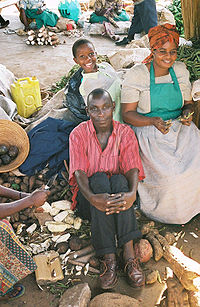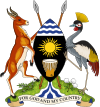71.191.20.238 (talk) No edit summary |
m one more |
||
| (One intermediate revision by the same user not shown) | |||
| Line 7: | Line 7: | ||
==International trade and finance== |
==International trade and finance== |
||
[[Image:2006Ugandan exports.PNG|thumb|right|Ugandan exports in 2006]] |
[[Image:2006Ugandan exports.PNG|thumb|right|Ugandan exports in 2006]] |
||
Since assuming power in early 1986, [[Museveni]]'s |
Since assuming power in early 1986, [[Museveni]]'s government has taken important steps toward economic rehabilitation. The country's infrastructure—notably its transport and communications systems which were destroyed by war and neglect—is being rebuilt. Recognizing the need for increased external support, Uganda negotiated a policy framework paper with the IMF and the [[World Bank]] in 1987. It subsequently began implementing economic policies designed to restore price stability and sustainable balance of payments, improve capacity utilization, rehabilitate infrastructure, restore producer incentives through proper price policies, and improve resource mobilization and allocation in the public sector. These policies produced positive results. [[Inflation]], which ran at 240% in 1987 and 42% in June 1992, was 5.4% for fiscal year 1995-96 and 7.3% in 2003. |
||
Investment as a percentage of [[Gross domestic product|GDP]] was estimated at 20.9% in 2002 compared to 13.7% in 1999. Private sector investment, largely financed by private transfers from abroad, was 14.9% of GDP in 2002. Gross national savings as a percentage of GDP was estimated at 5.5% in 2002. The Ugandan Government has also worked with donor countries to reschedule or cancel substantial portions of the country's external |
Investment as a percentage of [[Gross domestic product|GDP]] was estimated at 20.9% in 2002 compared to 13.7% in 1999. Private sector investment, largely financed by private transfers from abroad, was 14.9% of GDP in 2002. Gross national savings as a percentage of GDP was estimated at 5.5% in 2002. The Ugandan Government has also worked with donor countries to reschedule or cancel substantial portions of the country's external debts. |
||
Uganda is a member of the [[WTO]]. |
Uganda is a member of the [[WTO]]. |
||
Revision as of 20:34, 9 January 2010

Endowed with significant natural resources, including ample fertile land, regular rainfall, and mineral deposits, it is thought that Uganda could feed the whole of Africa if it was commerically farmed[1]. The economy of Uganda has great potential, and it appeared poised for rapid economic growth and development. However, chronic political instability and erratic economic management produced a record of persistent economic decline that has left Uganda among the world's poorest and least-developed countries. The national energy needs have historically been more than domestic energy generation, though large petroleum reserves have been found in the west.
After the turmoil of the Amin period, the country began a program of economic recovery in 1981 that received considerable foreign assistance. From mid-1984 on, however, overly expansionist fiscal and monetary policies and the renewed outbreak of civil strife led to a setback in economic performance.
International trade and finance

Since assuming power in early 1986, Museveni's government has taken important steps toward economic rehabilitation. The country's infrastructure—notably its transport and communications systems which were destroyed by war and neglect—is being rebuilt. Recognizing the need for increased external support, Uganda negotiated a policy framework paper with the IMF and the World Bank in 1987. It subsequently began implementing economic policies designed to restore price stability and sustainable balance of payments, improve capacity utilization, rehabilitate infrastructure, restore producer incentives through proper price policies, and improve resource mobilization and allocation in the public sector. These policies produced positive results. Inflation, which ran at 240% in 1987 and 42% in June 1992, was 5.4% for fiscal year 1995-96 and 7.3% in 2003.
Investment as a percentage of GDP was estimated at 20.9% in 2002 compared to 13.7% in 1999. Private sector investment, largely financed by private transfers from abroad, was 14.9% of GDP in 2002. Gross national savings as a percentage of GDP was estimated at 5.5% in 2002. The Ugandan Government has also worked with donor countries to reschedule or cancel substantial portions of the country's external debts.
Uganda is a member of the WTO.
Currency
Uganda began issuing its own currency in 1966 through the Bank of Uganda.[2] Prior to the failure of the East African Currency Board, Uganda used other countries' currency.
There have been six changes of currency since 1966, but the 1987 version has been stable. Upgrades to it have been intended to decrease counterfeiting and make the currency more useful.
Agriculture
Agricultural products supply nearly all of Uganda's foreign exchange earnings, with coffee alone (of which Uganda is Africa's leading producer) accounting for about 27% of the country's exports in 2002. Exports of apparel, hides, skins, vanilla, vegetables, fruits, cut flowers, and fish are growing, and cotton, tea, and tobacco continue to be mainstays.
Most industry is related to agriculture.
Industry
The industrial sector is being rehabilitated to resume production of building and construction materials, such as cement, reinforcing rods, corrugated roofing sheets, and paint. Domestically produced consumer goods include plastics, soap, cork, beer, and soft drinks. Major Cement manufacturers like 'Tororo Cement Ltd' caters to the need of building and construction material consumers across East Africa.
Transportation and Communications
Uganda has about 30,000 kilometers (18,750 mi.), of roads; some 2,800 kilometers (1,750 mi.) are paved. Most radiate from Kampala. The country has about 1,350 kilometers (800 mi.) of rail lines. A railroad originating at Mombasa on the Indian Ocean connects with Tororo, where it branches westward to Jinja, Kampala, and Kasese and northward to Mbale, Soroti, Lira, Gulu, and Pakwach. Uganda's important road and rail links to Mombasa serve its transport needs and also those of its neighbors-Rwanda, Burundi, and parts of Congo and Sudan. An international airport is at Entebbe on the shore of Lake Victoria, some 32 kilometers (20 mi.) south of Kampala.
The Uganda Communications Commission (UCC) regulates communications, primarily "delivered through an enabled private sector."[3]
See also
- Economy of Africa
- Ministry of Finance, Planning and Economic Development (Uganda)
- Uganda Investment Authority
- Uganda Securities Exchange
- List of banks in Uganda
- Banking in Uganda
External links
- Uganda Ministry of Finance, Planning and Economic Development
- Uganda Investment Authority; Sector analysis reports available
- Economy of Uganda at Curlie
- The Uganda Business Index
- Uganda Business Directory
References
- ^ Aid and other dirty business by Giles Bolton. Page 24. ISBN: 978-0091914356
- ^ History of the CurrencyBank of Uganda,2007
- ^ Uganda Communications Commission
